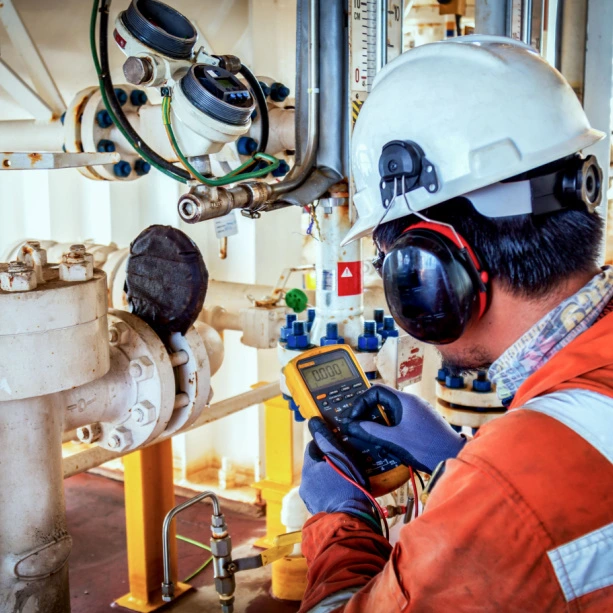Calibrated tools are an essential part of manufacturing operations requiring precision and accuracy in their work. Calibrated instruments are used to ensure measurements are exact and consistent. They are tools that have been adjusted to meet specific measurement standards. Using calibrated tools ensures that measurements are precise, consistent, and accurate.
How Calibrated Tools Work
Calibrated tools work by comparing the measurement values of a tool to a known standard. The standard is usually a tool or instrument that a national standards organization or a third-party calibration laboratory has calibrated. The comparison is made by measuring a sample with both the tool and the standard, recording any differences between the two measurements. The tool is then adjusted, if necessary, to align with the standard. Calibration is done to ensure that the measurements obtained from a tool are accurate, reliable, and repeatable.
Increase Your ROI by Investing in AirFinder OnSite
- Low Cost. AirFinder OnSite XLE is a fraction of the cost of competitors' pricing.
- Long Battery Life. XLE lasts up to 7 years with hundreds of location updates daily.
- Increased Efficiency. Spend less time looking for assets, and more time being productive.
Why You Should Monitor Your Calibrated Tools
Calibration is critical for ensuring the reliability and accuracy of any measuring instrument. Failure to calibrate your instruments regularly can lead to measurement errors, which can result in costly mistakes or even safety hazards. Tracking calibrated tools allows you to maintain a record of the calibration status of your instruments and helps you plan and schedule recalibration activities efficiently. Let’s look at the top three benefits you’ll gain from tracking your instruments.
Improve Product Quality
The quality of your finished inventory determines a lot more than you may realize. A poor-quality finished product can have two outcomes: it can be scrapped and discarded or unknowingly sold to a customer. Neither scenario is ideal. If the product needs to be scrapped, you wasted time, money, and resources on something you won’t see an ROI on. If you accidentally sell it, you have to deal with the consequences of an unhappy customer. You’ll still have to remake the product, costing you additional time, money, and resources. You also risk losing the customer from additional purchases down the road to your competitor, along with any of their friends they share the poor experience with.
If the tool you’re using to create a product is properly calibrated, you know for a fact that a portion of the tool will be high-quality. No more scrapped products or replacement costs for sending a customer a new product for free. When you track your tools, you’ll have quality control and be able to make something high-quality the first time.
Increase Production Uptime
In any production process, time is money. When employees are spending all of their time producing goods, more goods can be produced in a day. When there are higher production numbers, there are more products to sell, making the company more money. When you lose track of your precision tools, you have to spend time searching for those tools. That means production numbers will decrease. When you have asset visibility, you can spend more time producing a quality product than searching for the tools you need to complete your job.
Ensure Industry Compliance
How compliant you are with industry regulations determines the future of your company. A lack of compliance can lead to legal fees, a hurt brand reputation, and in extreme cases, a shut down company. Depending on what you’re manufacturing, you may need tools to be calibrated in a specific way to ensure the safety of your employees. When these requirements are not adhered to, you could face employee injury and lawsuits.
Having complete visibility of tools and equipment with these types of requirements will prevent employees from getting injured and prevent any non-compliance fees you may have to pay. Tracking calibrated tools ensures that they are always calibrated and meet the necessary standards, preventing costly penalties and compliance issues.
Risks of Using Improperly Calibrated Tools
Not using calibrated tools can lead to inaccurate measurements, which can have serious, sometimes long-term consequences. These consequences are typically financial and even if they’re not at first, they eventually cause financial damage.
Let’s look at an example; say you are a tractor manufacturer. Each tractor you make has to be made to certain specifications depending on the customer. If you can’t find the torque wrench calibrated to the specifications of the specific tractor you’re working on, you can’t just use a different wrench or the tractor will be off. If the final product is even slightly off, the tractor will be unusable to the customer.
You don't have many options when you can’t find the proper wrench. You can either spend hours searching for it - which doesn’t guarantee you’ll find it - you can purchase a new one - which can be costly - or you can spend the time recalibrating a different tool - which could negatively impact future projects. None of these outcomes are ideal, so the best choice is to prepare for the possibility of loss and implement asset tracking technology.
How to Properly Track and Monitor Your Tools
The simplest and most effective way to track your calibrated tools is with asset tracking technology. This technology is an automatic way to track the location of your tools. With asset tracking, you don’t have to rely on sign-out sheets to find the information you need to know. Instead, you can look up the location in real time and find out where the tool you need is with up to 30-centimeter accuracy. All the information you get from asset tracking will help you improve product quality, increase production uptime, and ensure all industry compliance requirements are being met.
Our asset tracking system, AirFinder, can help you manage your calibrated tools. If you need a specific tool calibrated in a specific way to complete a job, you can only use that properly calibrated tool to ensure a high-quality finished product. Keeping track of these tools is difficult, and calibrated tools can easily get mixed up. AirFinder helps you avoid these mixups by providing you with location information about your tools so you can make sure you use the right one. Book a demo with our team of experts to gain a better understanding of how our solution works and the impact it will have on your operations.




